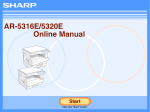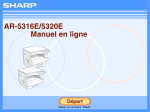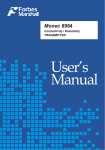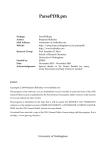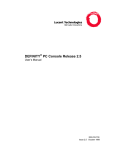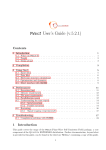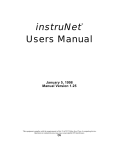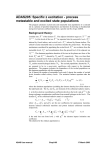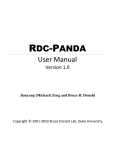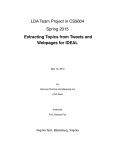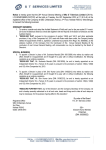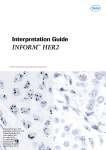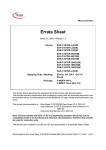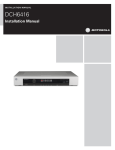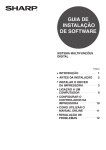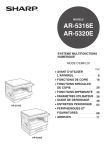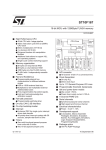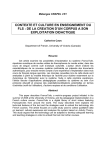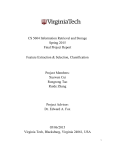Download User Manual
Transcript
POOL
User Manual
Version 1.0
Chittaranjan Tripathy and Bruce R. Donald
c 2001-2012 Bruce Donald Lab, Duke University
Copyright 1
Contents
1 Introduction
3
2 License Information
3
3 Citation Requirements
4
4 Installation
5
5 Configurations, Input and Output
6
5.1 File Organization of rdc-analytic . . . . . . . . . . . . . . . . . . . . . . . . . . . 6
5.2 Input Format . . . . . . . . . . . . . . . . . . . . . . . . . . . . . . . . . . . . . . . . 9
5.3 Output Format . . . . . . . . . . . . . . . . . . . . . . . . . . . . . . . . . . . . . . . 10
6 Examples
10
7 Utilities
11
1
Introduction
pool is a suite of programs for protein loop backbone structure determination from residual dipolar
couplings (RDCs) (only two RDCs per residue are required) in one alignment medium. Additional
experimental data, e.g., talos dihedral restraints and unambiguous backbone NOEs can be used to
filter the candidate loop conformations. pool is a part of rdc-analytic suite of programs for highresolution protein backbone fold determination from RDCs. rdc-analytic/pool is developed in
the lab of Prof. Bruce R. Donald at Duke University.
rdc-analytic/pool is free software and can be redistributed and/or modified under the terms
of the GNU Lesser General Public License as published by the Free Software Foundation, either
version 3 of the License, or (optionally) any later version. rdc-analytic is distributed in the hope
that it will be useful, but WITHOUT ANY WARRANTY; without even the implied warranty
of MERCHANTABILITY or FITNESS FOR A PARTICULAR PURPOSE. See the GNU Lesser
General Public License for more details. For full licensing details, including citation requirements
for the software, please refer to Section 2 and Section 3, respectively. This information can also be
found in the document PoolLicense.pdf enclosed with this package distribution.
pool is designed to compute high-quality protein loop backbone conformations from RDCs
in one alignment medium. The pool algorithm exploits the interplay between protein backbone
kinematics and the global orientational restraints derived from RDC data to naturally discretize the
conformation space by polynomial-root solutions, and represents the candidate conformations using
a tree. A systematic depth-first search of the conformation tree is used to enumerate all possible
loop conformations that are consistent with the data. pool uses efficient pruning strategies capable
of pruning the majority of the conformations that are provably not part of a valid loop, thereby
achieving a huge reduction in the search space. pool requires only two RDCs per residue in
α
α
α
one
alignment
medium, specifically, one RDC type from {C -H , C -C’} and one RDC type from
N
N-H , C’-N . Therefore, for a loop with n residues, while pool requires about 2n RDCs in total
to match with the number of degrees of freedom of the loop, it performs well when only 80-90% of
(the 2n) RDCs are present.
For the remaining degrees of freedom, for which RDC data is not available, pool employs
a finite-resolution uniform sampling of the Ramachandran map is used for that dihedral (degree
of freedom). For the cases with less RDC data, pool may take longer to compute the loop
conformations, since dihedral angles for which RDCs are missing, are sampled uniformly, thereby
increases the time complexity of the tree search. Also, in this case the solutions can be less accurate.
For loops with moderate amount of dynamics, pool can be used to compute ensembles of loop
conformations from RDCs.
This document contains license information, citations required upon using the software, and
the details of how to install and use pool.
2
License Information
The source header below must be included in any modification or extension of the source code of
rdc-analytic.
Source Header
This file is part of RDC-ANALYTIC.
3
RDC-ANALYTIC Protein Backbone Structure Determination Software Version 1.0
Copyright (C) 2001-2012 Bruce Donald Lab, Duke University
RDC-ANALYTIC is free software; you can redistribute it and/or modify it under
the terms of the GNU Lesser General Public License as published by the Free
Software Foundation, either version 3 of the License, or (at your option) any
later version.
RDC-ANALYTIC is distributed in the hope that it will be useful, but WITHOUT
ANY WARRANTY; without even the implied warranty of MERCHANTABILITY or FITNESS
FOR A PARTICULAR PURPOSE. See the GNU Lesser General Public License for more
details.
You should have received a copy of the GNU Lesser General Public License
along with this library; if not, see:
<http://www.gnu.org/licenses/>.
There are additional restrictions imposed on the use and distribution of this
open-source code, including: (A) this header must be included in any
modification or extension of the code; (B) you are required to cite our
papers in any publications that use this code. The citation for the various
different modules of our software, together with a complete list of
requirements and restrictions are found in the document license.pdf enclosed
with this distribution.
Contact Info:
Bruce R. Donald
Duke University
Department of Computer Science
Levine Science Research Center (LSRC)
Durham, NC 27708-0129
USA
email: www.cs.duke.edu/brd/
<signature of Bruce Donald>, August 04, 2012
Bruce R. Donald, Professor of Computer Science and Biochemistry
3
Citation Requirements
Any publications, grant applications, or patents that use rdc-analytic/pool must state that
rdc-analytic/pool was used, with a sentence such as “We used the open-source rdc-analytic/pool
software [Ref] to compute...”
In addition, you are required to cite our papers in any publications that use this code. The
primary citation corresponding to this software is [1]. The papers that can be cited based-on or
4
related-to this software are listed below.
[1] Chittaranjan Tripathy, Jianyang Zeng, Pei Zhou, and Bruce Randall Donald. Protein loop
closure using orientational restraints from NMR data. Proteins: Structure, Function, and Bioinformatics, 80(2):433–453, 2012.
[2] Chittaranjan Tripathy, Jianyang Zeng, Pei Zhou, and Bruce Randall Donald. Protein loop
closure using orientational restraints from NMR data. In Vineet Bafna and S. Sahinalp, editors,
Proceedings of the 15th Annual International Conference on Research in Computational Molecular Biology (RECOMB), Vancouver, BC Canada, volume 6577 of Lecture Notes in Computer
Science, pages 483–498. Springer Berlin / Heidelberg, 2011.
[3] Anna Yershova, Chittaranjan Tripathy, Pei Zhou, and Bruce Randall Donald. Algorithms
and Analytic Solutions using Sparse Residual Dipolar Couplings for High-Resolution Automated
Protein Backbone Structure Determination by NMR. The Ninth International Workshop on the
Algorithmic Foundations of Robotics (WAFR), 68:355–372, 2010.
[4] Jianyang Zeng, Jeffrey Boyles, Chittaranjan Tripathy, Lincong Wang, Anthony Yan, Pei Zhou,
and Bruce Randall Donald. High-resolution protein structure determination starting with a
global fold calculated from exact solutions to the RDC equations. Journal of Biomolecular
NMR, 45(3):265–281, 2009.
[5] Bruce R. Donald and Jeffrey Martin. Automated NMR Assignment and Protein Structure Determination using Sparse Dipolar Coupling Constraints. Progress in Nuclear Magnetic Resonance
Spectroscopy, 55(2):101–127, 2009.
[6] Lincong Wang, Ramgopal R. Mettu, and Bruce R. Donald. A Polynomial-Time Algorithm for
De Novo Protein Backbone Structure Determination from NMR Data. Journal of Computational
Biology, 13(7):1276–1288, 2006.
[7] Lincong Wang and Bruce Randall Donald. Analysis of a Systematic Search-Based Algorithm for
Determining Protein Backbone Structure from a Minimal Number of Residual Dipolar Couplings.
In Proceedings of the 2004 IEEE Computational Systems Bioinformatics Conference (CSB04),
Stanford CA, pages 319–330, 2004.
4
Installation
Since pool is written in Java, it requires JDK 1.7. Henceforth, it is assumed that JDK 1.7 has
already been installed. To install pool
1. Unpack the tar file in a directory of your choice. Then go to the (sub)directory that contains
the directory structure shown in Figure 1.
2. The Java files are in the directory ./src/analytic/, and the class files (after compilation)
will be in the following directory: ./analytic/. To compile the Java files type the following
two commands:
javac -d .
javac -d .
-classpath ./javax/vecmath:./Jampack/Jampack:.
-classpath ./javax/vecmath:./Jampack/Jampack:.
5
./src/analytic/*.java
./src/utilities/*.java
For convenience, we have provided a shell script with the name compile.sh. Executing this
script will compile the Java files.
3. This completes installation, and pool is ready for use.
4. To run the program type the following command:
java analytic/Pool <arguments>
The <arguments> that are supplied to pool can be found by typing
java analytic/Pool -help
5
Configurations, Input and Output
The inputs to rdc-analytic are (1) one RDC type from {N-HN , C’-N } and one RDC type from
{Cα -Hα , Cα -C’ } measured in one alignment medium; (2) the core, that is, the SSEs of the NMR
structures with no loops on it; (3) the alignment tensor computed from the core of the respective
NMR structures and the experimental RDCs using singular value decomposition (SVD); and (4) the
primary sequence of the loop to instantiate the appropriate residue-specific Ramachandran map.
Additional experimental data, e.g., talos dihedral restraints and unambiguous backbone NOEs
can also be used by pool.
5.1
File Organization of rdc-analytic
The directory structure of rdc-analytic is shown in Figure 1.
Henceforth, we denote the main working directory (mainDirectory in Figure 1) for pool by a
period (.). The Java source files are located in the folders ./src/analytic/ and ./src/utilities/.
The Java binary class files are in the folders ./analytic/ and ./utilities/.
To run pool on input data set to compute loops, we create a directory (call it master directory),
inside which the input files, the output files and the log files are organized. To illustrate this, let
us consider an example of computing the loop VAL17-ILE23 of ubiquitin. Let the master directory
be ./EXPERIMENTS/1d3z 17 23. The master directory contains the file dirArch.txt (or a file
with any name that contains the directory architecture information and passed as argument to
analytic/Pool). This file contains the information about all the input, output and log file names.
Therefore, the name of the files and directories under the master directory can be changed to (or
specified as) any valid directory and file names by the user. In our example we used the following
names as supplied in dirArch.txt:
inputDirectory: input_files_1d3z
// e.g., input directory: ./input_files/
inputDataDirectory: input_data_files
//e.g., Input Data Directory: ./input_files/input_data_files/
inputParameterDirectory: input_parameter_files
//e.g., Input Parameter Directory: ./input_files/input_parameter_files/
6
mainDirectory/
src/
*.java
analytic/
*.java
utilities/
analytic/
*.class
utilities/
*.class
docs-Manual-License/
PoolManual.pdf
PoolLicense.pdf
masterDirectory/
directoryArchitectureFile.txt
input_data_files/
coreWithEndAnchor.pdb
rdc_medium1.txt
seq.txt
input_parameter_files/
loop.txt
Parameter.txt
output_files/
log_files/
solutionFragments.pdb
mostRecentLeaf.pdb
solutionLog.txt
Figure 1: Directory structure of pool.
Each directory and file name in the directory
masterDirectory/, including the master directory masterDirectory/, can be customized (defined or renamed) by the user.
7
outputDirectory: output_files
logDirectory: log_files
// input data directory must contain RDC, NOE information, dihedral angle
// restraints from TALOS+ etc.
//program parameter directory must contain:
//
(1) the set of parameters to be used for the program, and
//
(2) the RDC scaling factor information (i.e., how your RDCs are mutually comparable)
RDC and CSA Files in Medium1: rdc_medium1.txt
RDC and CSA Files in Medium2: null
//RDC and CSA Files in Medium2: rdc_medium2.txt
programParameterFile: parameter.txt
SSeInfoFile: sse.txt
sequenceFile: seq.txt
loopConfigurationFile: loop.txt
dihedralRestraintFile: talos.txt
noeRestraintFile: noe.txt
// **** Warning:
not recommended to change the settings below **** //
bestFragmentPdbFile: solutionFragments.pdb
solutionTreeLogFile: solutionLog.txt
mostRecentFragmentCorrespondingToALeaf: mostRecentLeaf.pdb
Note that in the above specifications of file and directory names, the part left to the colon (:)
symbol is a tag used by the program, and the part right to the colon symbol is the user-supplied
name. For example, above the input directory is specified to be input files 1d3z. It has two
sub-directories, namely, input data files and input parameter files. input parameter files
contains the input data files and the core of the protein. The directory input parameter files
contains two files: loop.txt and parameter.txt.
The file loop.txt contains the specification of the loop as shown below:
// Format is @loop(beginResidueNumber, endResidueNumber,
8
closureDistanceThreshold, gridResolutionForPhiPsi,
DepthAtWhichStericCheckerTurnsOn, pdbFileContainingGlobalFold,
phiTypeRdcRmsdThreshold, psiTypeRdcRmsdThreshold, Syy, Szz,
numberOfSearchTrees);
@loop(17, 23, 1.0, 5.0, 6, 1D3ZBB_CAHA_NHN_POF.pdb, 2.0, 1.0,
15.457906239256296, 24.715711838306476, 1000)
@computeNow(17, 23)
Note that here the tag @computeNow, if not specified the loop anchors must be specified as
command line arguments while invoking analytic/Pool.
The file parameter.txt looks like the following:
//
//
//
//
//
//
//
//
**RDC Scaling Factors**
The flag scaleRdcTo can be set to one of the values from the following set:
{scaled, CA_HA, N_HN}. It sets the values of the prefactors (Dmax) for
the different types of RDCs measured. If the data has already been scaled,
then use the flag scaled. If the data are to be scaled wrt. CA_HA then set
the flag to CA_HA, and if the data are to be scaled wrt. N_HN then set the
flag to N_HN. We recommend to use scaled RDCs for our program or to scale the
RDCs wrt. CA_HA.
@scaleRdcTo CA_HA
// Alignment media name for RDCs mest be medium1, medium2, etc.
@rdcMediumName medium1
// Only two RDCs in the same alignment medium required
@typesOfRdcsToBeUsedForAnalyticSolutions CA_HA, N_HN
// Can be used to filter the solutions further
@typeOfRdcsToBeUsedForRefinement CA_HA, N_HN
The relative scaling of the RDCs must be specified for correct interpretation of RDC data. Also,
the RDCs to be used can be specified here. For this release @typeOfRdcsToBeUsedForRefinement
must be specified to have the same types as @typeOfRdcsToBeUsedForRefinement.
The formats of the input files are described below.
5.2
Input Format
noe.txt
Only a sparse set of unambiguous backbone NOEs can be used by pool at this time. These NOEs
can be obtained from chemical shift analysis of small proteins, or Isoleucine-Leucine-Valine methyl
labeling strategies used for larger proteins. xplor format for NOEs is used, e.g.,
// example NOE
9
assign ((resid 5 and name HA)) ((resid 67 and name HN)) 3.555 3.555 0.876 !
The program requires that the interacting proton names conform with the latest PDB naming
convention. A line comment in the file noe.txt starts with // as shown above.
rdc medium1.txt
This file contains the RDCs in xplor format, e.g.,
assign ( resid 500 and name OO)
( resid 500 and name Z)
( resid 500 and name X)
( resid 500 and name Y)
( resid 15 and name N)
( resid 15 and name HN) -10.5000 0.0000 0.0000
The RDCs are read from this file.
seq.txt
This file specifies the amino acid sequence of the protein in the format
residueNumber threeLetterIUPACAminoAcidName.
talos+ Dihedral Restraints in talos.txt
We use talos + dihedral restraint format to specify dihedral restraints predicted from the analysis
of the chemical shift information.
5.3
Output Format
The output directory, is automatically created when pool executes, and the ensemble of loop
conformations are written into solutionFragments.pdb, the file specified in dirArch.txt against
the tag bestFragmentPdbFile.
In addition, a directory is created to keep the log files for the execution of pool. The log
file solutionLog.txt and mostRecentLeaf.pdb respectively hold the progress of the execution of
pool, and the fragment corresponding to the most recently evaluated leaf node of a solution tree.
6
Examples
This distribution comes with seven examples of how to prepare the input files and run pool on
proteins. For ubiquitin (two examples), experimental NMR data is used. For the rest five proteins,
since no NMR data is available, simulated RDCs are used. These loops vary in size (i.e., the number
of residues in the loop) from 6 to 12. Specifically, the lengths of the seven loops are 6, 7, 8, 12, 12,
12 and 12.
To invoke pool for each of these loops, the following commands can be issued (in parallel
without any problem) in any order:
java analytic/Pool -masterdir EXPERIMENTS/1d3z_17_23/
10
java analytic/Pool -masterdir EXPERIMENTS/1d3z_7_12/
java analytic/Pool -masterdir EXPERIMENTS/1ds1/
java analytic/Pool -masterdir EXPERIMENTS/1dqz/
java analytic/Pool -masterdir EXPERIMENTS/1cnv
java analytic/Pool -masterdir EXPERIMENTS/1dysA/
java analytic/Pool -masterdir EXPERIMENTS/1oyc/
7
Utilities
For convenience, we provide some basic utilities that comes with rdc-analytic/pool. To facilitate
faster learning of the use of these utilities, we provide examples in the directory
./EXPERIMENTS/experimentsToTestUtilities/.
• To align two structures and extract information such as backbone RMSD for ranges of residues
(with or without alignment), and compute the magnitudes rotation and translation for alignment, we provide the utility StructureAligner.
To learn more about the command the options type:
java utilities/StructureAligner -help.
For example, to run the StructureAligner utility, you can use the following command (or
something similar for your set up):
java utilities/StructureAligner
-pdbfile EXPERIMENTS/experimentsToTestUtilities/1ghh/1GHHModel1.pdb
-pdbfile EXPERIMENTS/experimentsToTestUtilities/1ghh/1GHHModel2.pdb
-atomtypes N CA C -ranges 2 12 72 80
• To simulate RDCs using a structure and an alignment tensor, we provide the utility RDCSimulator.
To learn more about the command the options type:
java utilities/RDCSimulator -help
For example, to run the RDCSimulator utility, you can use the following command (or something similar for your set up):
To run the RDCSimulator utility you can use the following command (something similar for
your set up):
java utilities/RDCSimulator
-masterdir EXPERIMENTS/experimentsToTestUtilities/1oyc/
-pdbfile EXPERIMENTS/experimentsToTestUtilities/1oyc/1oyc afh.pdb
-Szz 8.8465e-04 -Sxx yy -1.2187e-03 -Sxy -6.5320e-04 -Sxz 6.0936e-05 -Syz 3.4005e-04
-rdctypes N HN CA C
11
• To test the fit of RDC data with structural coordinates, we provide the utility
OrientationalRestraintAndStructureFitter.
To learn more about the command the options type:
java utilities/OrientationalRestraintAndStructureFitter -help
For example, to run the OrientationalRestraintAndStructureFitter utility, you can use
the following command (or something similar for your set up):
java utilities/OrientationalRestraintAndStructureFitter
-masterdir EXPERIMENTS/experimentsToTestUtilities/1ghh
-pdbfile EXPERIMENTS/experimentsToTestUtilities/1ghh/1GHHModel1And2.pdb
-rdctypes N HN CA C CA HA
-printbackcomputedrdcsincsrosettaformat -printbackcomputedrdcsinxplorformat
-ranges 20 30 -printbackboneinpof -printbackbonedihedrals
12













